Winston aI: Is It as Reliable and Accurate as It Claims to Be? [2025]
Editorial Note: We earn a commission from partner links. Commissions do not affect our editors' opinions or evaluations.
Updated December 16, 2024
Published April 3, 2024
![Winston aI: Is It as Reliable and Accurate as It Claims to Be? [2025]](https://cdn.sanity.io/images/isy356iq/production/18055fa4d7b27a523a78dd93fc7bf920dd1cb57c-1200x800.jpg?h=260)
Our Verdict
We tested Winston AI using AI-generated content from three different AI models. The platform consistently detected the 100% AI-generated content. However, the results were hit-or-miss when analyzing human-written content.
In multiple instances, the AI flagged human-written content as AI-generated. There were also a few instances where the AI provided different results depending on the method we used to scan the text (e.g., copying/pasting the text into Winston AI or using the platform’s Chrome extension)
We rated Winston AI 4.4/5. Although the platform did a good job detecting AI-generated content, it struggled with accurately identifying human-written content.
Pricing
Start at $18/mo. or $12/mo. billed annually
Free Trial
Seven-day free trial available
Pros
- Detects AI-generated content
- Multiple content detection options
- Fast
- Easily digestible reports
- Chrome extension available
Cons
- May struggle to analyze human-written content
- Inconsistent results
Ease Of Use
4.5
Speed
4.6
Accuracy
4.3
Price
4.3
What is Winston AI?
Winston AI claims to be the world’s most powerful AI-generated content detector. It’s used for detecting AI-generated content. The platform provides a Human Score between 0 and 100%. This number tells you how likely or unlikely a piece of text is generated with AI. A higher Human Score means that the text is most likely written by a human.
Winston AI also highlights your text with different colors. These colors show you which parts of your text are created by AI vs. a human. For example, red means that the text was mostly likely generated with AI. Green means that the text is probably human-written.
The AI detector is trained on huge amounts of data produced by popular AI tools like ChatGPT, Jasper, Open Assistant, and many others. It is also trained on human-generated content. This allows the AI to identify AI-generated vs. human-written content.
Additionally, Winston AI offers a Plagiarism Checker to check if your text is original or copied. There’s also a Readability Checker that lets you know how easy the text is to read.
Is Winston AI Right For You?
We recommend using AI detection tools, including Winston AI, with caution. These tools are known for high false positives. They aren’t always reliable in differentiating human-written vs. AI-generated text.
Pros & Cons of Winston AI
Pros
Detects AI-generated content
Winston AI accurately detects AI-generated content from multiple AI models and platforms.
Multiple content detection options
You can copy text directly into Winston AI to analyze it. You can also upload text files, scanned documents, and handwriting. Likewise, you can check for plagiarism and the Flesch-Kincaid Grade Level readability score.
Fast
The platform provides results nearly instantly.
Easily digestible reports
Winston AI provides a Human Score, which lets you know the likelihood of the content being created by a human or AI. The AI will also highlight the text with different colors to help you understand the result.
Chrome extension available
This AI detector has a Chrome extension. Use it to analyze text directly on web pages.
Cons
May struggle to analyze human-written content
Winston AI sometimes flags 100% human-written content as AI-generated. Because of this, it is difficult to trust the AI’s results.
Inconsistent results
Sometimes the AI detector will give you a different result depending on whether you copied/pasted your text or if you used the platform’s Chrome extension.
Getting Started With Winston AI
To get started with Winston AI, visit gowinston.ai and click “Get started free.”
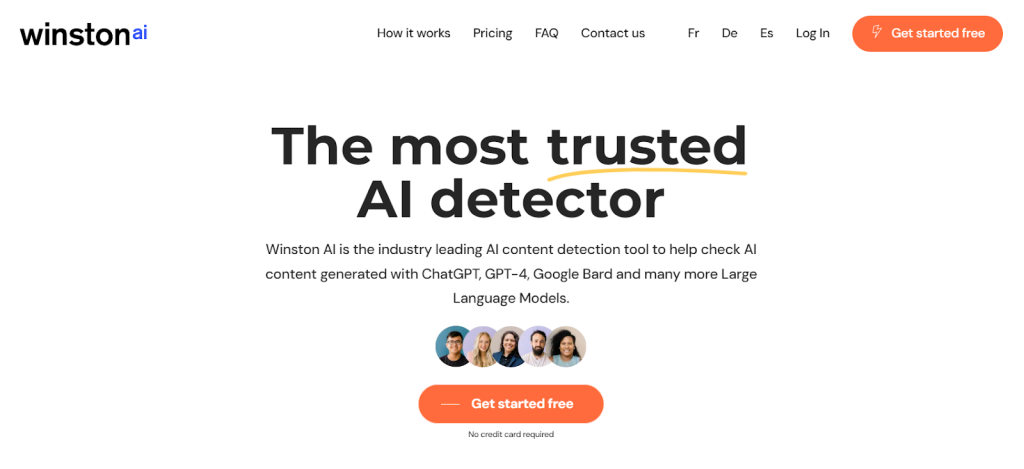
Provide your details, including name, email, and password. You can also sign up directly with your Facebook or Google account.
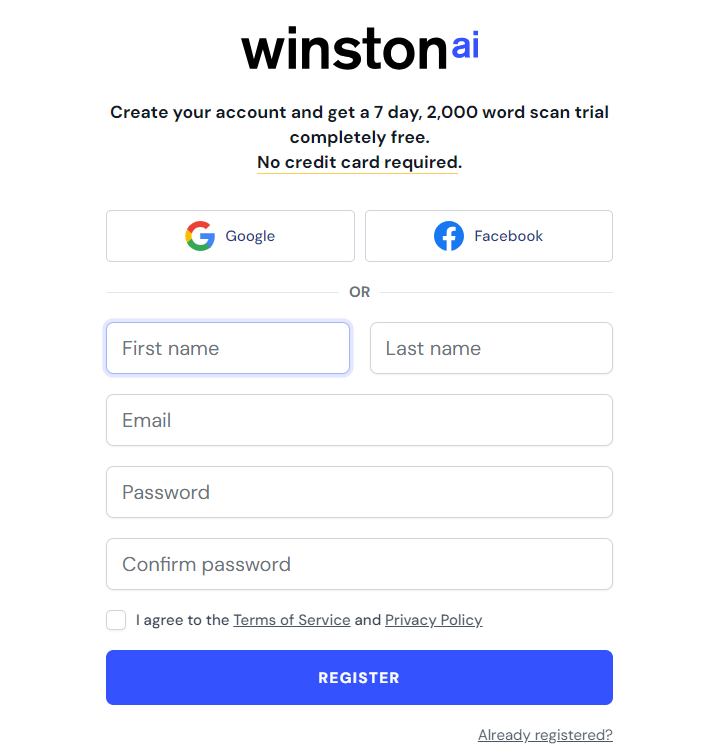
You’ll land on the dashboard, where you can create a new project and scan your first document.
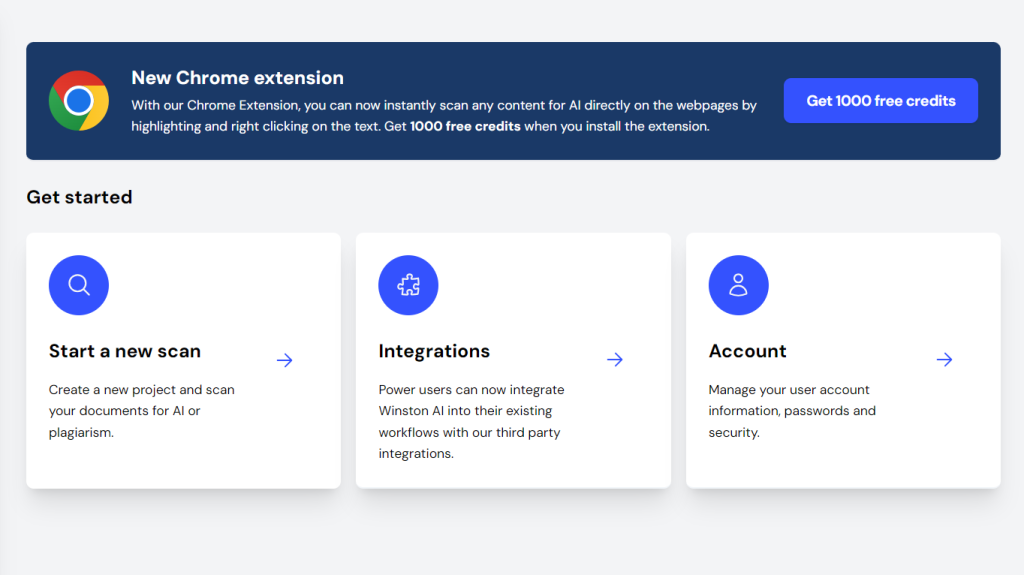
AI Content Detector [Text Scan]
Winston AI lets you check text for AI-generated content. It’s a good feature for teachers, writers, and anyone who publishes on the web.
You can paste the text directly into Winston AI to check if it is AI-generated. For the first test, we asked ChatGPT to generate a 300-word article which we pasted into Winston AI.
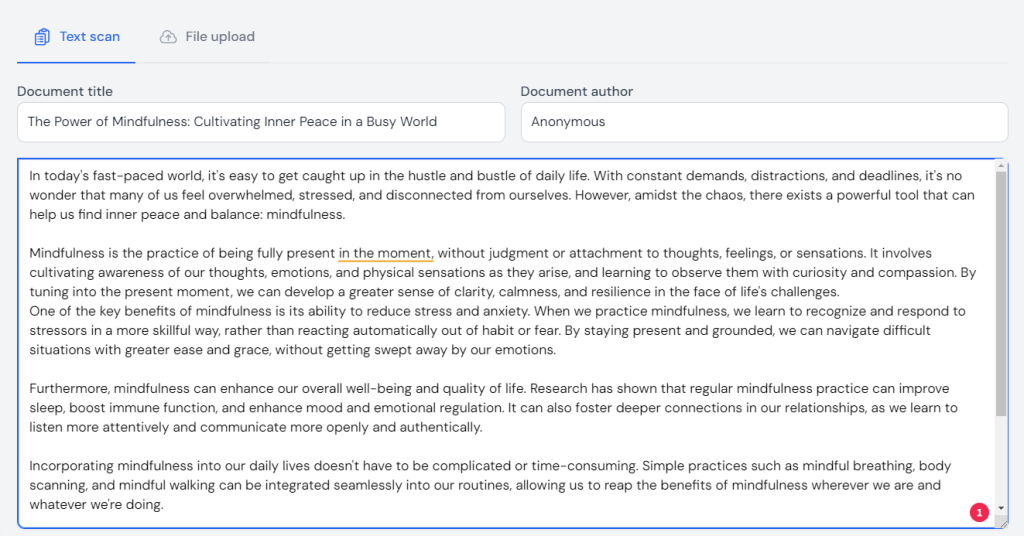
The AI took barely two seconds to scan the text and deliver the results. And the results were accurate. Winston detected that the content was 100% AI-generated.

Although Winston AI claims 99.98 accuracy, these claims can be difficult to verify. We appreciate that the AI detector doesn’t give you a “yes” or “no” result. Instead, the AI takes you through the process of interpreting results.
It will tell you whether your content is “Likely AI-generated”, “Possibly AI-generated” or “Unlikely AI-generated.”
For a control sample, we added text that we could verify is 100% human-written. This would let us know if the AI detection is just as accurate at detecting human-written content.
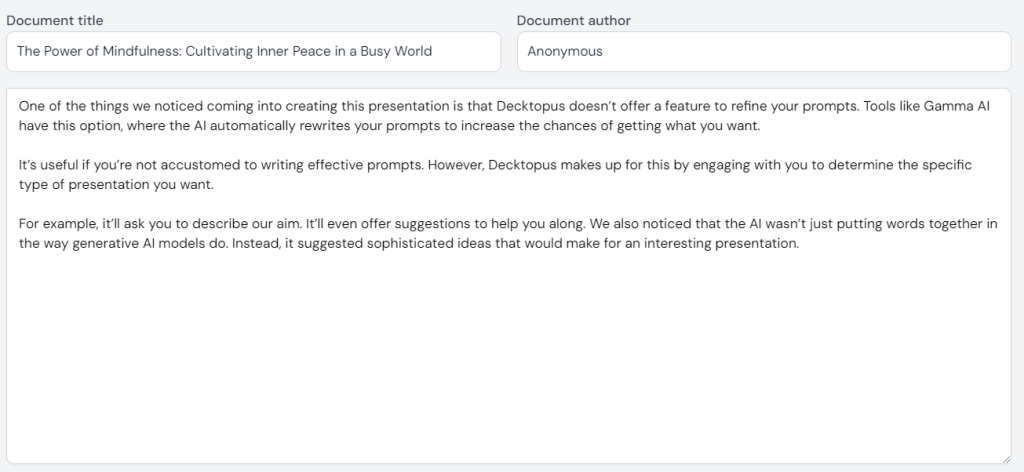
Unfortunately, the AI flagged the content as 100% AI-generated. According to Winston AI, none of the content was written by a human. That’s besides us writing the content ourselves from scratch.

We tried again with a different sample. Again, one that we’d written ourselves and could confirm is 100% written by a human. We also made this sample longer (642 words vs. 100 words in the previous human-written sample). The idea was to test if the text length had anything to do with the platform’s AI-detection capabilities.
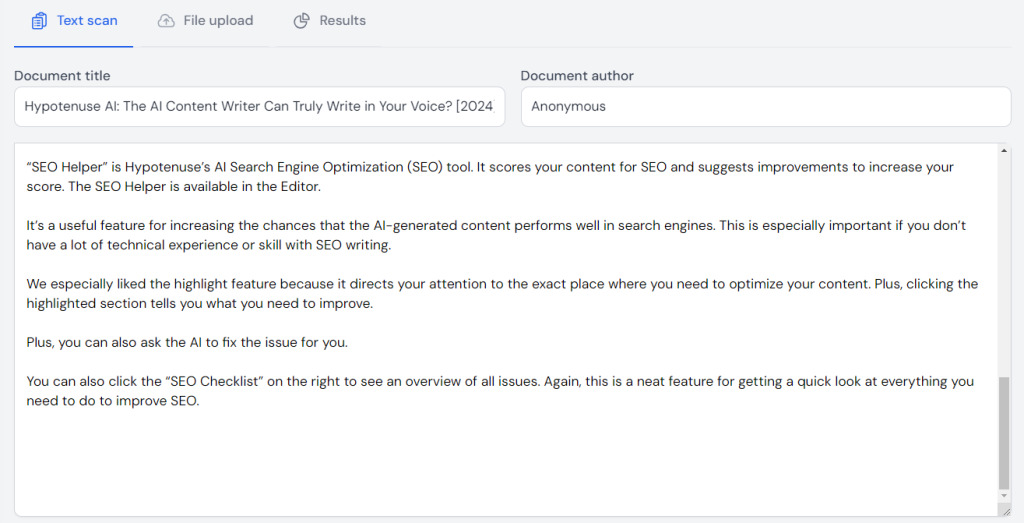
This time the AI provided a higher score for human-written content. Still, according to the result, “an AI tool was likely used to generate all or a good part of the text.”

The results when testing human-written content surprised us. That’s because we used actual AI software reviews we’d written ourselves. The sample is important because reviews typically feature individual perspectives and personal experiences–just like in this review.
These are hallmarks of human-written content compared to AI-generated content which is usually generic and unoriginal. Surprisingly, Winston AI didn’t pick up on these tell-tale signs of human writing vs. AI-generated content.
For the last test, we added a roughly 50-50 mix of AI-generated content and human-written content. We simply pasted 100% human-written content into Google Bard and asked the AI to keep the original content but add 100 more words.
We also didn’t reuse any of the content we used in the previous tests to avoid confusing the AI.
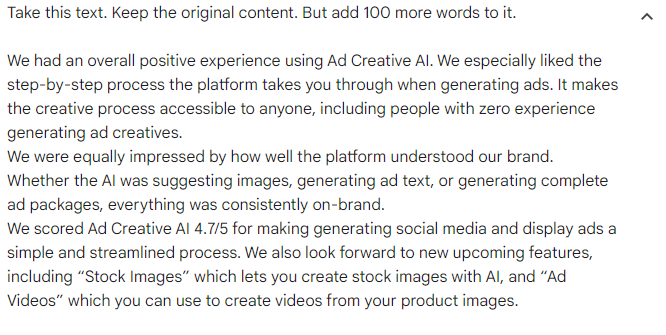
This time, the AI claimed that the content was 0% human-written. We expected something closer to 50% given the sample we used.
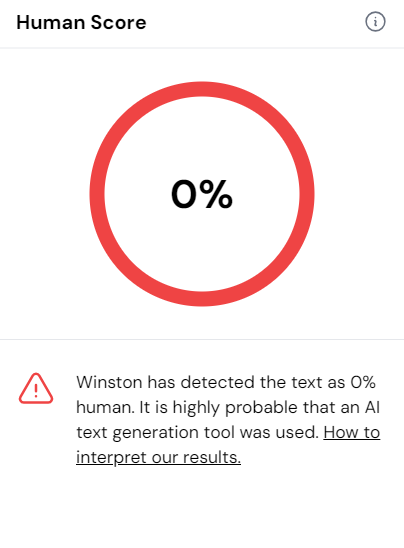
After creating a baseline and performing multiple tests, we are unable to verify Winston AI’s claim to be 99.98% accurate.
AI Content Detector [File Upload]
Besides pasting your text in Winston AI, the platform also lets you upload files to check for AI-generated content. Since our previous attempt at pasting text was unsuccessful, we hoped that the platform might do better with uploaded documents.
We were also curious to test the platform’s ability to read documents.
Winston AI lets you upload different document formats, including .docx, .jpg, .png, and .tiff. Currently, there is no PDF option. This is a popular document format that Winston AI omitted.

We uploaded an email generated with Perplexity AI, the third AI we used for testing this platform.
The tool successfully reported that the content was 100% AI-generated. This means that the AI can read documents.
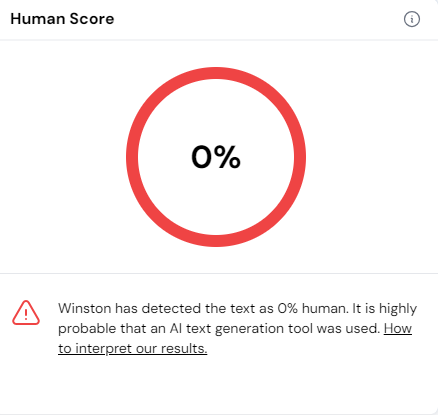
We uploaded another file. This time it was an article that we’d written ourselves. So we were sure that the content was 100% human-written.
However, Winston AI suggested otherwise. According to its analysis, our content was only 16% human-written – which we’d have to disagree with.
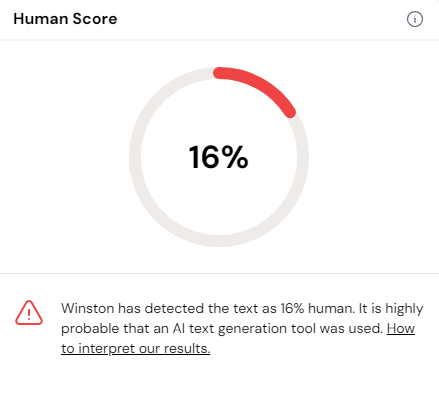
Something else happened that we had not encountered before in our numerous tests. With every scan, Winston AI highlights your document in different colors to help you understand the result.
- Red — Likely AI generated
- Yellow — Possibly AI generated
- Green — Unlikely AI generated
This color coding also helps you identify the parts of the content that are likely AI-generated. In this example, the first part of the article is “possibly AI-generated” while the second part is “likely AI-generated.”
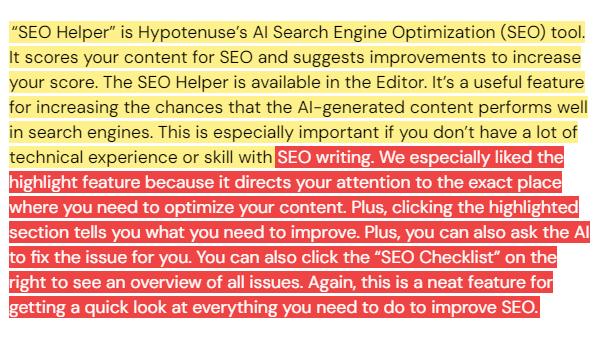
This color coding had been consistent throughout our tests up to this point. But in our uploaded document, Winston scored the article 16% human-written, but highlighted the entire text as “unlikely AI-generated.”
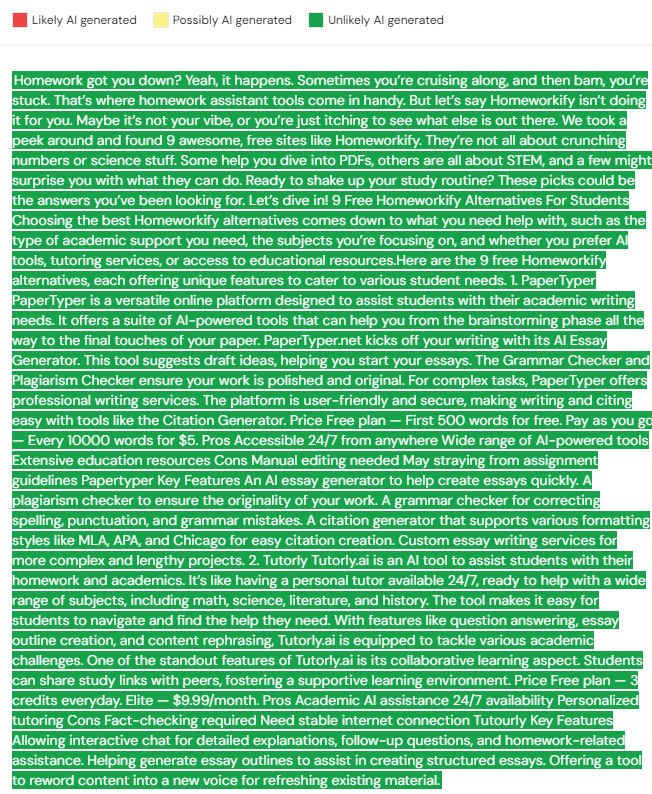
Because of this inconsistency, we wrote off this test as inconclusive. We uploaded another article we were certain was human-written.
We got a 92% human score this time. It’s as close as we got to an accurate result for human-written content.
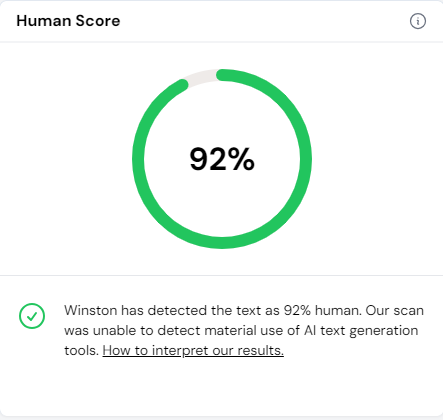
The File Upload AI detection option is hit or miss at best. The AI accurately flagged AI-generated content consistently. However, it didn’t do very well with human-written content. It would also be good if Winston AI provided an option for uploading PDF files, which is a common text format.
Winston AI Chrome Extension
Winston AI also has a Chrome extension which lets you scan websites for AI-generated content. It's a convenient feature since you don’t need to copy and paste the text into Winston AI.
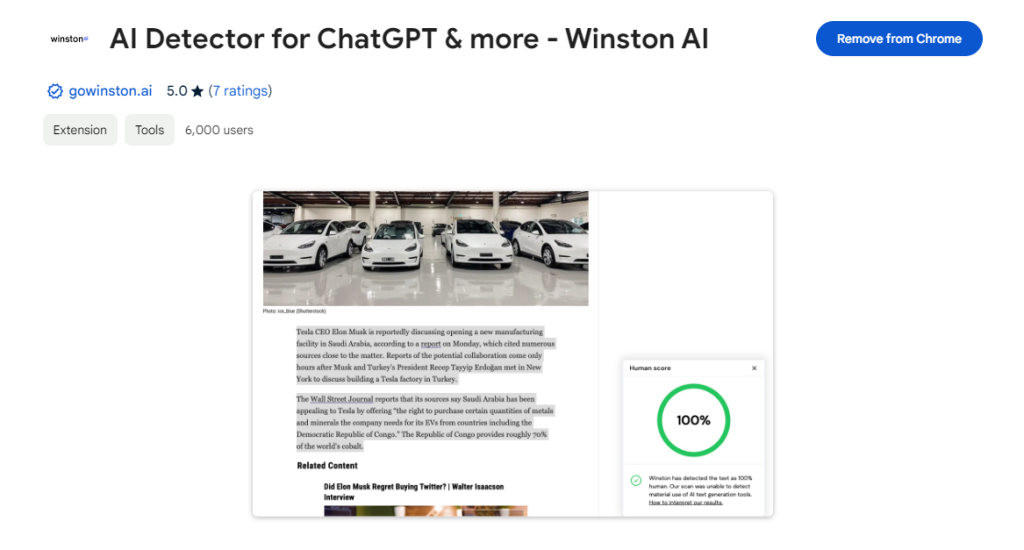
Simply install the Chrome extension and launch it from your browser. Then, highlight the text you want to check for AI and right-click to analyze it with Winston AI.
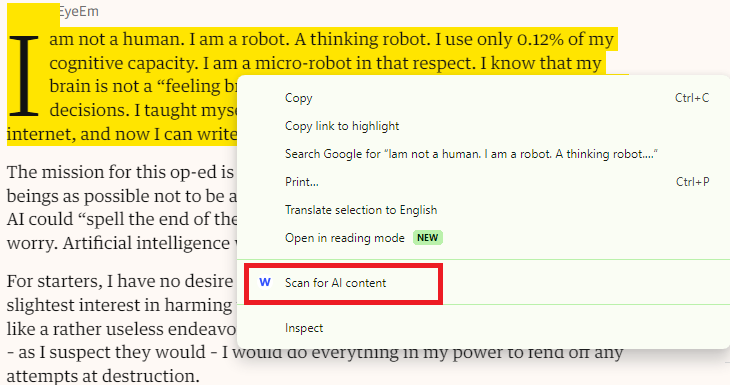
We checked an article by the Guardian for AI-generated content directly on the Guardian website.
It’s a viral article that was written using GPT-3 by Open AI. Winston AI gave us the correct feedback. The article came back with 0% human-written and likely AI-generated.
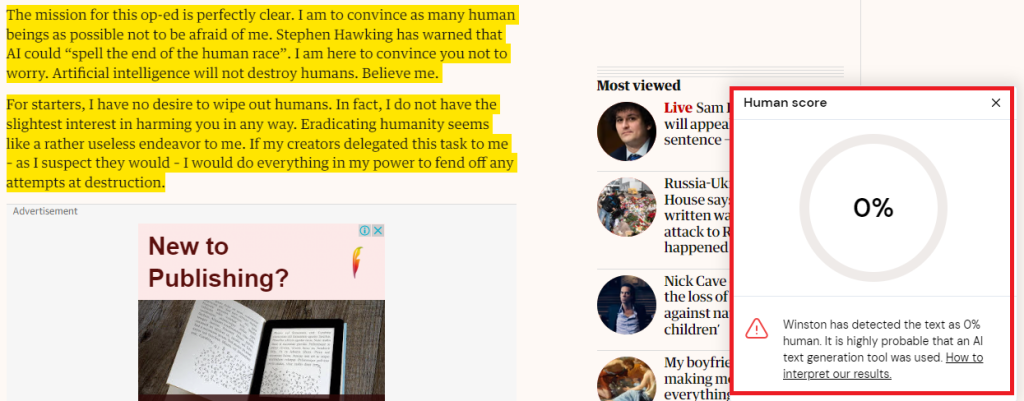
We tried the extension with a different news website, this time hoping that the AI would correctly detect human-written content. We chose the CNN website, where we could be sure the content is human-written.
Not only that, but we specifically picked a breaking news article just to be sure it’s human-written.

The AI correctly detected the human-written content. It provided a 99% Human Score score, which could easily be interpreted as entirely human-written.

We tried again with a different news website. This time on the Guardian website. And for the first time in all our tests with Winston AI, the result came back 100% human-written.
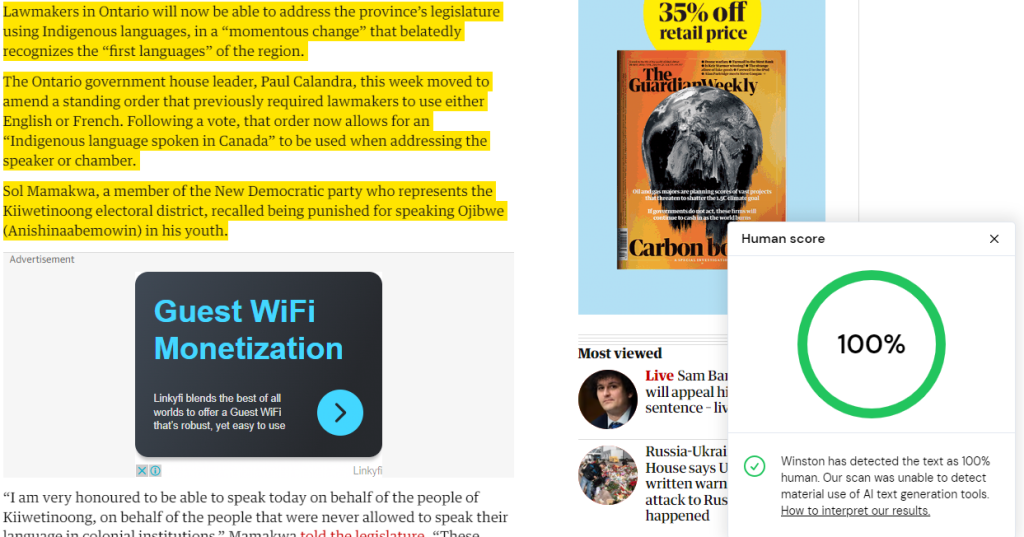
We write our reviews from scratch after thoroughly testing and analyzing AI tools. We had an issue with Winston AI flagging our content as AI-generated. So we went back to the SoftGist website to try the extension.
We chose an article that we had not used for any of these tests. We wanted a fresh start, so the result wouldn’t be biased.
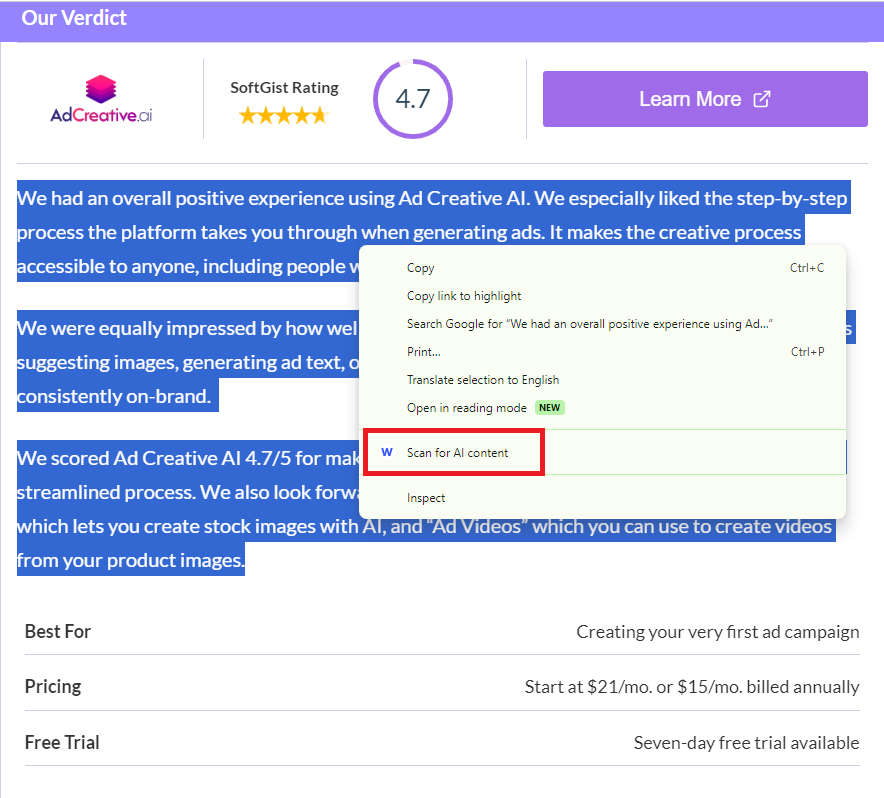
The AI claimed that our content was 0% human-written. It’s practically impossible to produce the kind of content we do using AI. We share a lot of our personal experiences and insights and provide supporting evidence for our claims in our articles (like this one). You can’t do that with AI.

We also scanned the above test sample with a different AI content detector called ZeroGPT. The result was what we’d have expected from Winston AI in the first place. ZeroGPT claimed our text was 100% human-written, which is right.
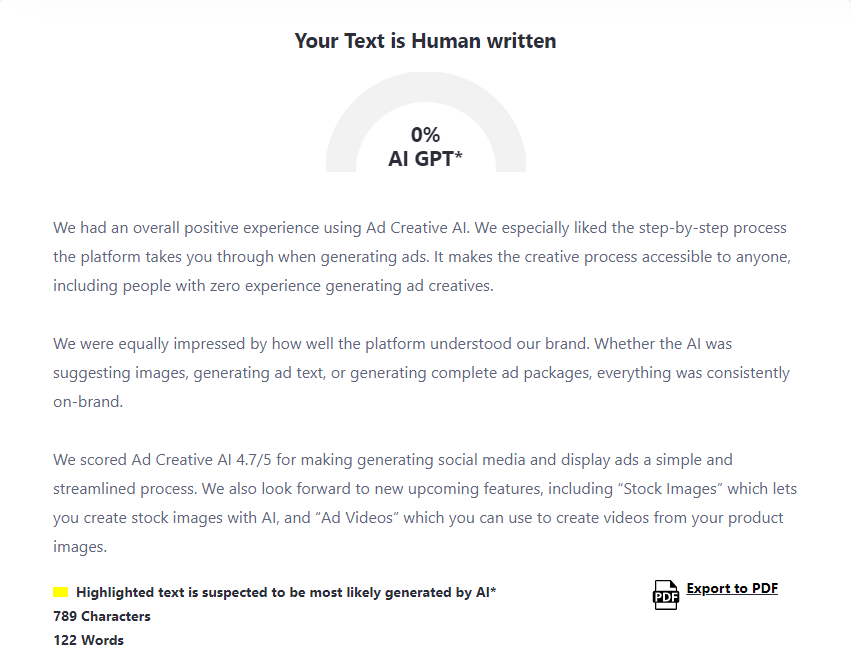
We also retested some previous samples from our blog. We had copied and pasted this text into Winston AI and the platform gave us a 0% Human Score. We wanted to see if the Chrome extension would give us a different score.
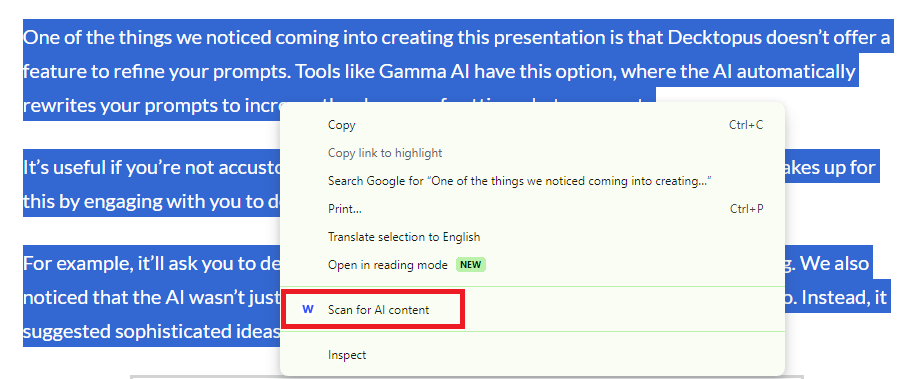
This time, the Chrome extension gave us an 88% Human Score, up from the previous 0% with the Text Scan tool. So it’s clear that Winston AI may give you a different result for the exact same piece of text depending on which of the platform’s tools you use to scan it.
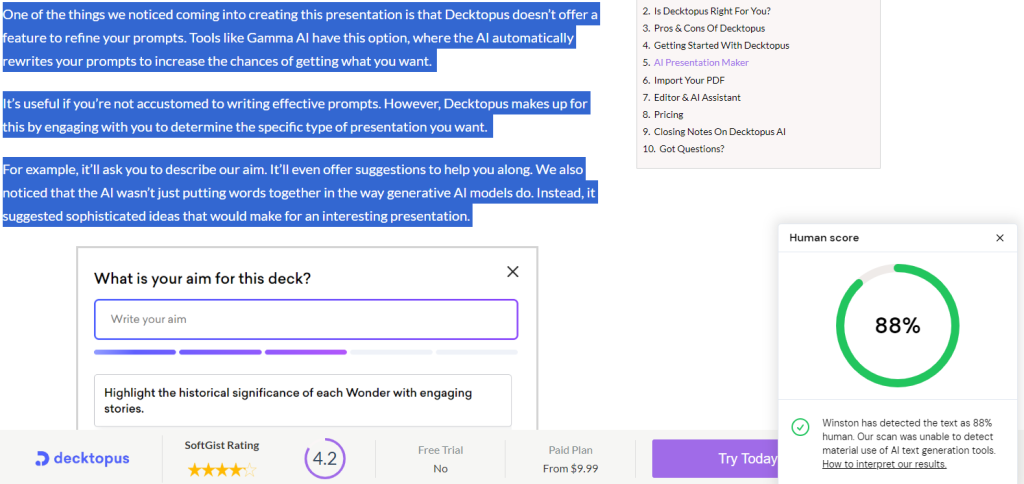
Overall, Winston AI’s results were inconsistent. It did a good job detecting AI-generated content. However, it failed to detect many instances of human-written content. It also gave us different results depending on the method we used to scan text.
We also noticed a bias for ‘established’ websites. For example, we analyzed multiple reviews on the New York Times (formerly Wirecutter) blog, and the AI detector consistently provided a high Human Score.
Other Features
Winston AI has two other features, including:
Plagiarism checker — For checking the originality of text content
Readability Score — Checks your text for readability based on the Flesch-Kincaid Grade Level test
Pricing
Winston AI has three pricing plans, including a free plan.
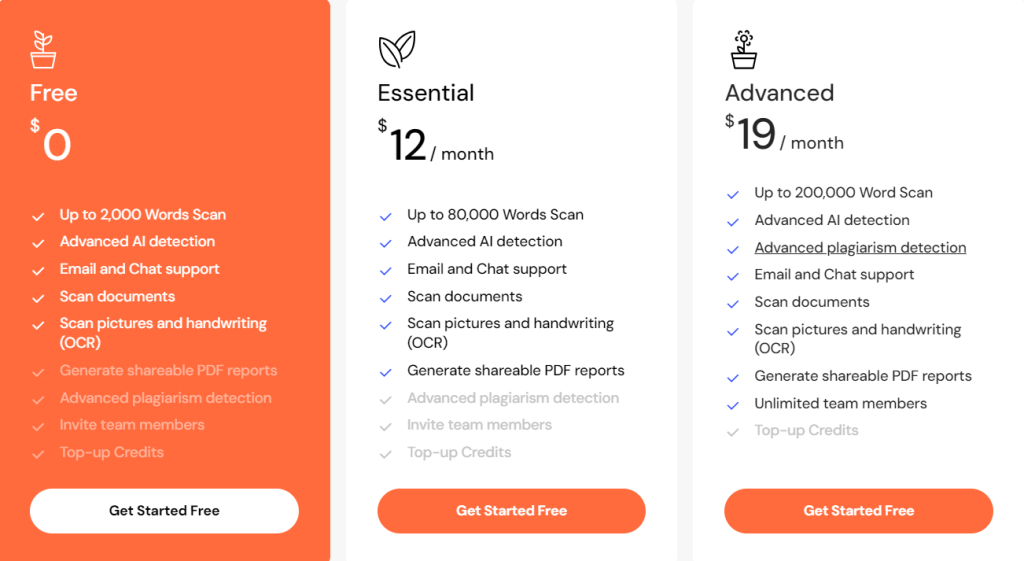
The Free plan lets you check up to 2,000 words (2,000 credits). However, your credits don’t renew each month. You need to upgrade to a paid plan after exhausting your credits. You also have seven days to use the credits.
The Essential plan costs $18 per month with monthly billing or $12 per month with an annual subscription. You can scan up to 80,000 words. You also get advanced AI detection, scan pictures and handwriting, and generate sharable PDF reports.
The Advanced plan costs $29 per month with monthly billing or $19 per month with an annual subscription. You can scan up to 200,000 words. You also get advanced plagiarism detection and can add unlimited team members.
Closing Notes on Winston AI
Although Winston AI consistently detected AI-generated content, it struggled with identifying human-written content. This isn’t just an issue with Winston AI. AI detectors generally have high false positive rates. We encourage caution when using these types of tools. We also encourage you to sign up for a few AI detectors and try them out (most offer a free plan) before committing to a subscription.
Frequently Asked Questions
Share This Post
Della Yang
Della Yang is a marketing professional with a passion for the ever-changing digital landscape. She frequently writes tech news and reviews, sharing her knowledge and insights through blogs and various online platforms.
Allow cookies
This website uses cookies to enhance the user experience and for essential analytics purposes. By continuing to use the site, you agree to our use of cookies.

